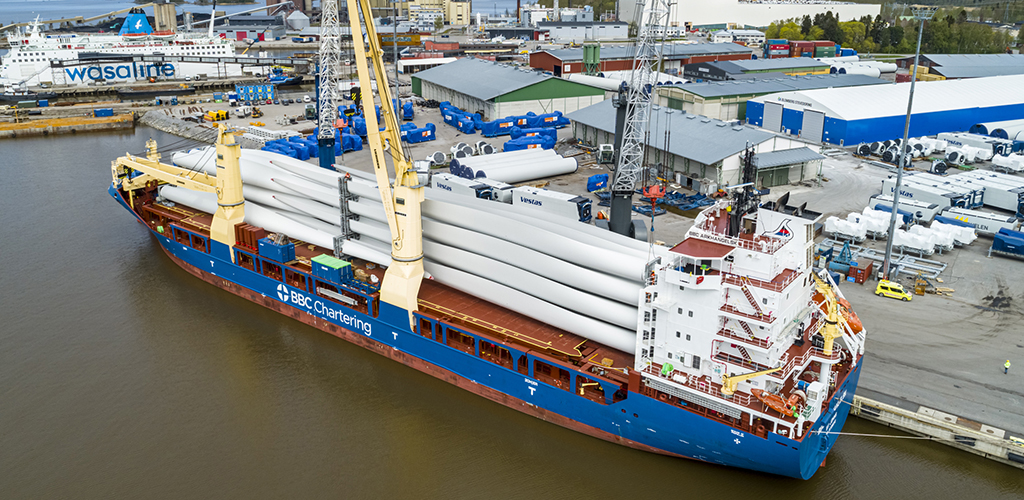Charter Indices Diverge on Future Demand

Multipurpose charter rates continue to rise in December as pressure on global shipping supply chains shows little sign of diminishing before the end of the year.
The latest figures from maritime consultancy Toepfer Transport suggest that rates are now up more than 170 percent year-on-year, with demand for tonnage holding firm and competition for space remaining high.
“Time charter contracts are being fixed well in advance with only very few spot market opportunities,” said Yorck Niclas Prehm, head of research at Toepfer. “Securing vessel space is the focus of most carriers which are now looking at longer charter periods of three years and above for the standard MPP-Types.”
Holiday Demand
Data from Toepfer for November shows that the rise in rates continued unabated, as delays at ports around the world and fears over the new Omicron variant have compounded issues for shipping lines struggling to meet seasonal demand.
“The high demand for MPV tonnage remains steady and even the upcoming holiday season (Christmas, New Year and Lunar New Year) does not cause a significant slow-down of the ongoing rise,” Prehm added.
In December last year, Toepfer’s Multipurpose Index (TMI) sat at just US$6,931 hitting this level this after six months of growth from a nadir of US$6,381 in June 2020. This December, however, the index has hit US$18,973, representing a 173.73 percent increase year-on-year, a 9 percent month-on-month change, and a three-year compound annual growth rate of 35.7 percent.
Prehm sees little sign of this momentum dissipating either as a lack of availability of capacity shapes the market. Toepfer’s Multipurpose Shipping Report is published monthly and provides an index based on a 12,500 deadweight-tonne multipurpose /heavy-lift F-Type vessel for a six to 12-month charter period. Headquartered in Hamburg, Germany, Toepfer Transport is one of the largest S&P brokers in the city and its research department has a particular focus on the MPP/Heavy-lift Market.
MPV Rate Plateau
Maritime consultancy Drewry also reported a rise in charter rates this month, but is more cautious in its outlook, predicting that a weakening in spot prices elsewhere may mean that rates have now reached a plateau for the multipurpose sector.
The firm's Drewry Multipurpose Time Charter Index increased to $10,487 per day in November, but growth slowed from the 2.5 percent increase in October to just 1.9 percent last month.
“The slowing pace of Drewry’s Index is largely attributable to weaker growth in both the container and bulk sectors over November, subduing rates particularly in the shortsea market,” said Susan Oatway, head of multipurpose shipping research at Drewry, and member of the Breakbulk Europe Programme Advisory Board. “Continued capacity constraints kept the spot market demand high, but the competing sectors both reported weaker charter rates.”
The firm’s index is nonetheless up 63 percent since the start of the year and 69 percent since November 2020. Drewry expects the index to increase a further 1.1 percent in December to reach $10,600 per day.
Drewry’s monthly Multipurpose Time Charter Index is a measure of charter rates over a one-year period, the index compares a basket of vessel types, including breakbulk and project cargo ships of different sizes, and forecasts the market movement over the coming month. Headquartered in London, Drewry provides maritime research consultancy, market insights and advisory services across the global shipping sector.
A weakening of demand in the container sector towards the end of the year, as Christmas demand lessens, is expected to relieve some pressure on project carriers, allowing firms to begin the return to more traditional cargoes in 2022. But while spot rates in competing sector have fallen from their record high, Drewry expects demand in both the short-sea and longer haul project cargo sectors to remain firm “as supply constraints continue.
“For the project carrier sector demand remains high for the medium term particularly, around a resurgence in confidence for oil and gas projects due to the strengthening oil price and scarcity of LNG over 2021. Add to this the continued demand from the renewable sector and the market may be slowing but it is unlikely to weaken significantly in the medium term at least,” Drewry predicts.
Newbuild Crunch
A further factor for multipurpose capacity in the longer term is the lack of newbuild vessels in the market at present. The pandemic, and ensuing disruption to container shipping, has driven a surge in new orders for container vessels, filling shipyards orderbooks and delaying regeneration in the MPV fleet.
“There is very low activity in the orderbook. While many owners are hunting for newbuilding slots, the lack of availability, or better the limited amount of shipyards willing to look into building multipurpose vessels, is the main bottleneck at the moment,” Prehm said.
Topefer’s China Newbuilding Price Index shows that prices have rocketed since last year as all available sipbuilding capacity has been soaked up. Container lines, sitting on record profits from the last year, have soaked up nearly all available slots with new container vessels not likely to hit the water until well into 2023.
As the supply chain crisis has worsened this year, consumer good prices have surged to a 31-year high and pre-tax profit for container shipping could be as high as US$300 billion, according to Drewry, with more increases to come.
“To seasoned observers of the container market, typing these numbers on a page is frankly surreal,” Drewry states. “Stronger-than-expected spot rate movement in the third quarter and a longer supply chain recovery timeline are behind our reason to upgrade the outlook for average global freight rates — spot and contract — for 2021.”
